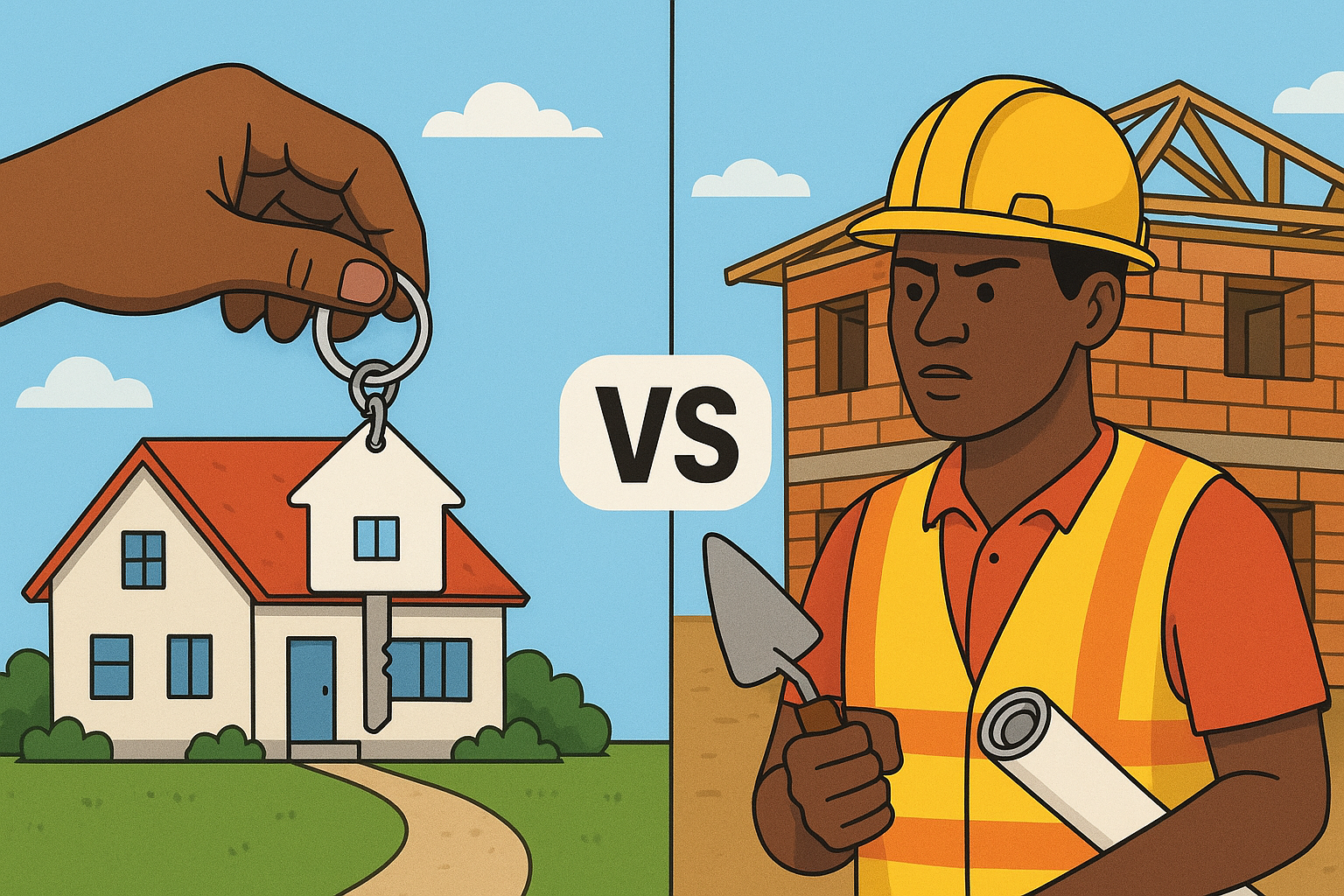
Buy vs. Build in Uganda: A Complete Cost and Process Breakdown for 2025/2026
The Ugandan Dream: Navigating the Path to Homeownership in 2025/2026
Owning a home remains one of the strongest symbols of stability and achievement in Uganda. As the economy grows and the population nears 46 million, more Ugandans are pursuing this dream than ever. But one question defines the 2026 housing landscape: is it wiser to buy an existing home or build one from scratch?
This report distills the data, legal processes, and financial realities behind both paths—equipping aspiring homeowners with practical, evidence-based insights.
The 2026 Real Estate Landscape
Uganda’s property market is expanding alongside economic growth projected at 6.4–7% for FY 2024/25. While traditional prime zones—Kololo, Nakasero, Bugolobi—remain coveted, rising prices are pushing buyers toward emerging suburbs such as Kira, Najjera, Munyonyo, Lubowa, and Gayaza. These areas now define the middle-class frontier, offering affordable land and expanding infrastructure.
The 2026 general elections are likely to cause a short-term slowdown in transactions, followed by renewed activity post-election as confidence returns.
At the heart of the “buy vs. build” decision lies a trade-off between location and control:
- Buying favors proximity, prestige, and convenience.
- Building offers affordability, customization, and long-term value.
The “Buy” Path: Speed and Certainty—at a Cost
The Buying Process
Set Your Budget and Financing Plan – Confirm available savings, mortgages, or loans. Allow 3–4% extra for taxes and fees.
Search for Property – Use licensed agents or verified platforms. Visit neighborhoods at different times of day.
Inspect Before You Commit – Hire an independent structural engineer to uncover hidden defects.
Conduct Legal Due Diligence – A property lawyer should confirm ownership, title authenticity, and encumbrances.
Sign a Sale Agreement – Include clear clauses on price, payment, and default penalties.
Transfer Ownership – After full payment and 1.5% stamp duty, register your title with the Land Registry.
Financial Outlook for 2026
Prime Locations – In Kololo, Nakasero, and Bugolobi, 3-bedroom homes range from $185,000 to $690,000 (UGX 695M–2.6B).
Mid-Tier Suburbs – Ntinda, Naalya, and Butabika average between $145,000 and $380,000 (UGX 545M–1.4B).
Emerging Zones – In Kira, Namugongo, and Gayaza, prices span UGX 140M–470M.
Additional Costs –
- Stamp Duty: 1.5%
- Legal Fees: 1–2%
- Land Registration: UGX 20k–50k
For a UGX 300M Home – Expect UGX 9–12M in transaction costs.
Recurring Costs –
- Service charges: UGX 200k–500k/month
- Property rates: often waived for owner-occupied homes.
Key Risks – Overpriced listings, poor finishing, and structural issues hidden by cosmetic upgrades.
The “Build” Path: Control, Customization, and Value
The Construction Journey
Buy Land Wisely – Verify title, check tenure type (Mailo, Freehold, or Leasehold), and ensure there are no disputes.
Plan Your Design – Hire registered architects and engineers. Secure building permits within 30 days; start construction within 12 months.
Hire a Qualified Contractor – Vet their references and previous work before signing.
Oversee Each Phase – Foundation, structure, roofing, finishing, plumbing, and electrical works.
Secure an Occupation Permit – Needed before you move in.
Cost Breakdown for 2026
Land (Wakiso or nearby suburbs) – UGX 25M–90M
Design and Permits – UGX 10M–15M
Construction (3-Bed Bungalow) – UGX 80M–130M
Stage Costs –
- Foundation: UGX 12–18M
- Superstructure: UGX 11–20M
- Roofing: UGX 13–16M
- Finishing: UGX 16–25M
- Plumbing & Electrical: UGX 10–15M
Typical Total – UGX 175M for a 3-bedroom home.
Common Risks – Budget overruns, inflation, and theft of materials.
Smart Move – Engage a project manager or developer for professional oversight.
Financing Options in 2026
Mortgage Loans (Stanbic, Centenary, dfcu) – Ideal for ready homes. Rates range between 16–20% per annum (UGX-based).
UNFCU Mortgages – For UN staff, with 5.9–7.9% USD-based rates and lower FX risk.
Construction Loans (NCBA, Stanbic, Wazalendo Sacco) – Tailored for builders, at 13–18%. Disbursed in stages, requiring 30% equity.
Equity Requirement – Most lenders demand 20–30% upfront, about UGX 45–55M on a UGX 150M project.
Incremental Building Trend – Many Ugandans fund projects in phases as income allows.
Buying vs. Building: 2026 Comparison
Total Cost – Buying averages UGX 258.7M, while building costs about UGX 175M. Building saves money if well-managed.
Upfront Payment – Buying needs 20% down (UGX 51.7M), while building needs 30% (UGX 52.5M). Both require similar liquidity.
Timeline – Buying allows move-in within 1–3 months; building takes 9–18 months.
Design Flexibility – Buying limits customization; building gives full control.
Risk Level – Buying risks hidden defects; building risks cost escalation. Both require due diligence.
Expert Takeaway
Buying makes sense if:
- You value time, convenience, and urban proximity.
- You have verified the home’s structural quality.
- You can access stable mortgage financing.
Building is ideal if:
- You prefer customization and long-term savings.
- You can supervise or hire a project manager.
- You are patient with extended construction timelines.
Final Word
The Ugandan dream of homeownership in 2026 is achievable for anyone who plans, verifies, and budgets with discipline. Whether you buy or build, success lies in due diligence, sound financing, and professional guidance—the true foundation of generational wealth.
RFdevelopers
Author
Ready to Experience Luxury Living?
Explore our exceptional developments and discover the perfect property for your lifestyle and investment goals.
